#troodont
Explore tagged Tumblr posts
Text
Well hello there, Stardust! I feel like I'm in a bit of a predicament and something tells me it's your fault。:✧˚*:・。

-Releases another dragon(adjacent) Loop into the wild-
I commissioned the lovely @nycroshears to draw Loop as a Rukemi; one of my OC species that I'm shoving in an AU I've been working on! An AU that started out as a scene that popped in my head when I was falling asleep of a rukemi grabbing Siffrin by the scruff and making them confess to their family...which turned into a massive AU I've been outlining for weeks now.
Rukemis as a species idea are nearing 20 years old at this point! I think it's past time I debut them in more than a few commissions thrown into the uncaring void of tumblr every few years. I'm not going to talk too much about them now; that'll be revealed in the AU itself!
Some more info about Rukemis + closeups below. (ISAT SPOILERS)



Fun facts about rukemis!
They're from a parallel Earth where the meteor that killed the dinosaurs glided past harmlessly.
They're descended from troodonts about 67-68mya who had a whack mutation that caused their front limbs to duplicate. They were very useless at first but others of the species found them SO ATTRACTIVE they ended up thriving and the wings over time evolved to be functional. So they are theropod dinosaurs, like t-rexes, velociraptors, and modern birds.
They evolved sapience not long before humans did after a smaller extinction event wiped out biodiversity in habitats adjacent to their native range.
Before they were relatively unassuming small tree-dwelling creatures similar to primates but with the bonus ability to fly. But with the new free real estate some of them branched out and rapidly evolved much larger sizes and intelligence comparable to our own. Now, they're roughly the size of small horses and stand about as tall as us when they're standing on all fours.
Now, parallel to our Earths, they exist a few hundred years more technologically "advanced" than us.
Their societal development was similar to ours at the start, including the destruction of their Earth's ecosystem, wars, oppression, and other fun things. But after ▮▮▮▮▮▮▮▮▮▮ and ▮▮▮▮▮▮▮▮▮▮ they mana▮ed to ▮▮▮▮ from the ▮▮▮s and bu▮▮d a ▮▮▮▮▮▮▮▮ ▮▮▮▮▮▮▮▮▮ ▮▮▮▮▮▮▮.
It was after they got their collective ▮▮▮▮ together that they gained the power to ▮▮▮▮▮▮ to other ▮▮▮▮▮▮▮▮ ▮▮▮▮▮, ma▮▮▮▮▮▮▮e ▮▮▮▮▮nts, h▮▮▮ ▮▮▮▮ds, and ▮▮▮▮▮▮▮▮ their ▮▮▮▮▮ into ▮▮▮▮▮ sop▮▮▮▮s upon ▮▮▮▮▮.
Now, many rukemis spend their lives trying to ▮▮▮▮ other ▮▮▮▮▮▮▮▮ not ▮▮▮▮ ▮▮▮▮▮ ▮▮▮▮ up like ▮▮▮▮ ▮▮▮.
Their designs were based on ▮▮▮▮ from ▮▮▮▮▮▮▮▮ ▮▮▮▮ and originally looked like your standard middle-schooler's white wolf rainbow wings + horns OC that you can see (here), but after 20ish years of workshopping they're now their own dragon dinosaur species (and are much, much gayer). This design is the most accurate and all others in the link are older versions.
They have three main sexes that are impossible to tell apart at a glance and have a much looser and queerer relationship to "gender" and family.
They generally live in family units of 3-8 adults + their children (now, often including humans and other sophonts) and have a much more relaxed & shifting hierarchy than humans generally do.
They are nice, and soft and warm.
Enter Loop, just a normal rukemi who just wanted to live a normal life as an astronomer working to discover extraterrestrial life on other planets (because finding life on parallel Earths just wasn't cool enough for them). After an ▮▮▮▮▮▮ by a ▮▮▮▮▮▮▮▮▮ ▮▮▮▮▮▮, they were thrown into the world of SASASAAP and eventually runs into Loop Siffrin struggling through their time loops all alone.
Originally, I created a random rukemi to aid ISAT Siffrin through the loops and join the family after they broke free of them. But after developing it for a while I realized I had no idea what to do with Loop so I just fused the two into one and tossed them into the Start Again world to help OG Siffrin instead.
(Sorry y'all, this Loop doesn't sparkle as they are made up of flesh and blood and not pure craft energy. They did get some cool "tattoos" some time before coming to SASASA:AP world looking like a celestial being, though! They look like the 2nd image to Siffrin. If they had more time they might found some glitter to make a more theatrical entrance.)
-Adds another "dragon" Loop to the pile-
#isat#in stars and time#isat loop#isat au#rukemi#dragon loop#my shitposts#sasasap#sasasaap#sasasaap loop#isat spoilers#sasasaap spoilers#art by nycroshears and some tweaks by me#because i didn't want to waste 5 hours of their life making them do tiny experimental changes for me fhaiewufh
94 notes
·
View notes
Text
Submissions Open!
Please submit any fictional dinosaurs that you want to be considered for the Best Fictional Dinosaur Tournament (alternatively referred to as the saurnament)!
Please submit the name of your FICTIONAL, NON-AVIAN (Triceratops - Troodont) dinosaur, AND the franchise of origin! Additionally, if you submit a non-theropod, I love you.
It would also make my life easier if you checked to see if the character has already been added before asking! (That's a read only list, submissions are done via ask!)
Only 6 characters per franchise will be allowed in the final cut, but don't let that stop you for now! I will be doing the filtering later.
Feel free to submit a picture of the character if you're asking off anon (not required). I will have to select at least one representative picture for each candiate; if nobody suggests any then I will have to look them up myself.
Have fun, and please REBLOG to help spread the word!

For all you fellow rule lovers, the detailed rules are under the cut:
Rule 0 (Dino Denial)
Candidates must be fictional dinosaurs.
All candidates must be fictional entities, created by a specific person or group to serve some fictive purpose. Examples that do count: The T-Rex from Jurassic Park, Blue from Jurassic World, any relevant sports mascots, specific named dinosaurs in documentaries NOT based on an existing named fossil. Examples that don't count: Any general species of dinosaur without citing a specific work, any dubious or contested species of dinosaur such as nanotyrannus, any named actual fossils such as Big Al.
-----------------------
Rule 1 (Di-No a Saur When I See One)
Candidates must be non-avian dinosaurs.
All candidates must either: a) BE an actual non-avian dinosaur, or b) have a design that is PRIMARILY INSPIRED BY one or more non-avian dinosaurs (and from here on out, consider "dinosaur" to effectively mean "non-avian dinosaur). Birds do NOT count for this poll; "dinosaur" here means Triceratops through Troodonts. Additionally, pterosaurs, icthyosaurs, plesiosaurs, mosasaurs, and other similar ancient reptiles do NOT count as they are NOT dinosaurs. (Example 1: Obviously, Aladar from Dinosaur counts, as he is an iguanadon, but Agumon, Godzilla, the Indoraptor, and Bastiodon all count too even though, strictly speaking, none of them are actually existing dinosaurs). (Example 2: Any birds, snakes, lizards, or other ancient reptiles/amphibians/whatever, such as Lapras, Rodan, Bulbasaur, and sea monsters do NOT count, as none of them are primarily based off of non-avian dinosaurs).
-----------------------
Rule 2 (The Digimon Clause)
Only a certain number of candidates will be allowed per franchise; currently set to 9.
In the final lineup there will be no more than a certain number of characters per franchise (probably 9, to be determined based on submission volume!) But don't let this affect submissions! Filtering for this rule will be done afterward.
-----------------------
Rule 3 (The Dragon's Dogma)
Dinosaurs only, no dragons, but dragonlike dinosaurs are probably fine.
Obviously, dragons do NOT count. However draconic characters that are still able to satisfy Rule 1 CAN count, provided that they can be construed as primarily dinosaur in origin. It can be hard to distinguish, but in general, factors that lean a character towards being more draconic than dinosaur include wings, a primarily serpentine body, and legs that stick out to the side rather than directly under the body. (Example: Guilmon is still clearly a dinosaur, so it counts. But by the time it becomes Megidramon, it is clearly more dragon than dinosaur.).
-----------------------
Rule 4 (Dinosauromorpha)
Shapeshifters allowed only if they ONLY become dinosaurs.
Non dinosaur characters that can turn into dinosaurs CAN have one or more of their dinosaur form(s) submitted, IF and ONLY IF their dinosaur form comes from the ability to specifically and ONLY turn into dinosaurs, NOT as the result of a broader power. (Example: Most Dino Squad members, each of whom can turn into one specific dinosaur, COUNT, but Beast Boy, who can turn into any dinosaur, because he can turn into any animal, does NOT count).
-----------------------
Rule 5 (How Did the Triceratops Speed Up His Computer?)
He gave it a good RAM Robotic dinosaurs allowed ONLY if they look primarily like living creatures, not vehicles or anything.
Partially or fully mechanized characters that satisfy Rule 1 DO count, provided that in addition to the criteria of Rule 1, the core form of the character is meant to resemble a living creature, rather than be a tank or vehicle with dinosaur parts. (Example: Grimlock counts, Mechagodzilla counts, Robirdo does not).
66 notes
·
View notes
Text
anything I didn't mention just pick the closest thing (compsognathids put with weird floofs, basal Neornithischians with Ornithopods, etc)
174 notes
·
View notes
Text

Now that I've excavated one of everything from all of Arlo's plots, I'm getting the Raptor Red fandragons their Thunder Lizards scenes.
Red already had one, so my second one went to Rusty here (fandragon of Red's sister). Appropriate since she's the one who introduces the pack to playing with troodonts!
13 notes
·
View notes
Text

I told myself I would never make Yi qi-descended wyverns, but alas, here I am. XD (NOTE: the information on this creature will be given multiple posts [linked at the bottom] because I am having troubles getting it to post as one singular post. You can find the link to part #2 at the bottom.)
Wandering Amphiptere
Kingdom: Animalia
Phylum: Chordata
Class/Clade: Reptilia (Sauropsida)
Clade: Archosauria
Clade: Avemetatarsalia
Clade: Dinosauria
Clade: Theropoda
Clade: Neotheropoda
Clade: Tetanurae
Clade: Coelurosauria
Clade: Maniraptoriformes
Clade: Maniraptora
Superorder: Scansoriopterygoidea
Order: Dracoviperoidea
Clade: Eudracoviperoidea
Family: Amphipterygidae
Genus: Ciconiavenator
Species: C. exulans (“wandering stork-hunter”)
Ancestral species: possibly Yi qi
Temporal range: early Pleistocene to recent (2 mya - present)
Information: As true flying dinosaurs, their distant avian cousins, attempted to colonize the skies, early wyverns found themselves in a predicament, unable to radiate into the large-bodied aerial predator niches the pterosaurs occupied (and continue to occupy) in near-totality, their uniquely specialized anatomy being both a blessing and a curse. As they began to increase in size, however, they faced competition from established coelurosaur clades, the troodonts and dromeosaurs in particular proving to be rather challenging to compete with, made even more complicated by the fact that the latter were now branching into arboreal niches themselves in the smaller microraptorian forms, and early mammals, too, were beginning to become more specialized in insectivore niches, which the early wyverns occupied. But whereas this would’ve normally spelled the end for such a clade, a minor extinction event near what was likely the Late Cretaceous gave them an opportunity to diversify: on the mainland of Archaeonesia, the microraptorians had gone extinct, along with several other clades of arboreal coelurosaurs. Based on genetic data, as the fossil evidence itself is too scarce to confirm directly, in this absence, they would begin to rapidly upsize and diversify, first radiating into the niches of small vertebrate predators and, over time, evolving into far larger forms which would eventually colonize mountainous areas, having outgrown the trees they once called home. It is only during the Paleocene, however, that direct fossil evidence emerges of this clade, and by then, they had already diversified into a variety of predatory niches, perfecting the art of gliding better than any group which came before. Continued: https://www.tumblr.com/captainswaglord500/767366398303420416/wandering-amphiptere-continued?source=share Continued 2: Electric Boogaloo: https://www.tumblr.com/captainswaglord500/767366685340712960/wandering-amphiptere-continued-2-electric?source=share Continued 3: You've Gotta Be Kidding Me!: https://www.tumblr.com/captainswaglord500/767366850349858816/wandering-amphiptere-continued-3?source=share
Continued (Part 4: The Final Chapter Part 1 [WHY, TUMBLR, WHY? T-T]): https://www.tumblr.com/captainswaglord500/767366997957902336/wandering-amphitere-continued-4-the-finale-part?source=share Continued (Part 5: The Final Chapter Part 2 [Please, I have a wife and kids!]): https://www.tumblr.com/captainswaglord500/767367092690386944/wandering-amphiptere-continued-5-the-finale-part?source=share
#scifi#fantasy#speculative evolution#novella#scififantasy#worldbuilding#fantasy creature#dragon#wyvern#sciencefiction#sci fi#speculative fiction#fantasy worldbuilding#scifi creature#scifi worldbuilding#dinosaurs#dinosaur
4 notes
·
View notes
Text
North America was a good end to the season, weird break from naming conventions aside!
Alamosaurus segment was a cool start. Was expecting it to be the last, but oh well. We didn't see much of the sauropods but it was still nice to see them. Tyrannosaurus, troodontids and Quetzalcoatlus all flocking to a dead one, and the Quetz actually scare off the T. rex. I'm sure some T. rex fanboy is upset about that somewhere, lol. but yeah, was a cool opening.
Oceans reject, staring Globidens and some ammonites. This was a nice strategy, and even as I always found Globidens interesting because of its teeth I didn't even consider more complex ways it could take down hard shelled prey.
The Pectinodon segment might've been my favourite. Unique cast, unique setting, and the critters themselves had lots of charm and character. The juvenile Pectinodon had nice colouration too, as was the touch of the father being the parent here, like actual troodont fossils.
The Triceratops segment was probably the most "typical" of the bunch, but it was still nice to see, especially all the individual variation between different trikes.
Nanuqsaurus hunting Ornithomimus was a nice end. Not my favourite segment, but still a different way of seeing tyrannosaurs hunt, especially because some of them probably COULD have been at least somewhat built for speed.
All in all, a good season! Not sure how I'd place it compared to Season 1, I feel similarly about both besides S2 having shorter length because they added the science stuff on the end of the eps.
Favourite episode... not sure. Maybe Badlands? You'd think it would be Islands, but I guess Badlands to me just felt the most consistent and cohesive, nitpicks about faunal choices in the third segment aside. Also can't go wrong with the Deccan Traps.
My favourite segments overall would be the Madagascar ones, however. Simosuchus, Adalatherium, and Beelzebufo help show the wonder of non-dinosaurs even as they shared the world with them.
As for the future, who knows what to expect? Season 2 was made mostly along Season 1, so now we don't know if BBC and Apple want to make more or not. If they did though, I'd be down! There's plenty to still explore.
13 notes
·
View notes
Text
Writing these posts, I'm really reminded that I should probably get around to coming up with a name for this setting.

Anyway, this world's version of Scandinavia is an island, and rather than fantasy vikings it is home to at least two species of non-human hominid. It's also home to crocodile-size temnospondyls, long after their extinction everywhere else.
But this post isn't about any of those. Instead, it's about another concept I'm recycling for this setting:

A giant derived troodontid. This guy was originally created for a post-apocalyptic alt-history dinopunk setting where the K-Pg extinction never happened but humans somehow evolved anyway, Ming China colonized western North America before the arrival of Europeans on the east coast, and then the Yellowstone caldera erupted in the late '70s and brought about a miniature ice age and the general collapse of global society. I eventually abandoned the project when I realized I didn't really want to put in all the effort that building out such a world would require on top of my other projects, but I did like the giant troodont concept so I'm reusing it here.
This time, rather than having evolved its giant size in order to occupy the megapredator niche left vacant by the extinction of tyrannosaurs in North America, this giant troodont got this big as a result of being on an island left to do its own evolutionary thing for millions of years. Its main gimmick is that not only is it extremely intelligent, at least corvid-level, but it has an unsettling talent for vocal mimicry that it often uses to lure in prey.
Imagine walking through a dark forest during the long subarctic winter, when suddenly you hear a distant voice calling for help. You follow the voice, but as you get closer and the voice becomes clearer you realize something about it sounds...off. Something about the pitch, the inflection, you can't quite put your finger on it but it just sounds wrong. And then you see something moving in the darkness between the trees, something big, that emerges into the moonlight, looking down at you with its glittering eyes, and it opens its long jaws, teeth glinting, and, with a twitch of its throat, you hear the cry again: Help me!
So yeah, I'd play these guys for maximum creepiness.
0 notes
Text
If Troodonts or another dinosaur had used stone tools, would paleontologist be able to tell?
0 notes
Text
There is a long prehistory of exchange between Asian and NA ecosystems due to the on-off again connection of the Beringia land bridge.
The ones I'm most aware of are during the Cretaceous, which has at least a few connections through. While most Dinosaurs are generally monospecific, the genus Saurolophus has two species, one in Asia (Sa. angustirostris) and one in North America (Sa. osborni)

(A is Sa. angustirostris, B is Sa. osborni)

Since we have skin impressions of both we can also get a potential idea on Pattern based on how the scales are arranged (while not a certain tell it can be a sign) and those scale patterns suggest that the Asian species has a more striped or barred pattern, while the NA one may be more spotted or mottled.
Tyrannosaurus rex also a close relative (if not it's ancestors) appearing in Asia as well around the same time, Tarbosaurus bataar and Zhuchengtyrannus magnus (or Tyrannosaurus bataar and magnus depending on who you ask). While not much is known of Z. magnus, Tarbosaurus is pretty well studied. There's a lot of ecological difference between the two despite usually being placed as sister species to one another. Tyrannosaurus being much more specialized in delivering bone crushing bites with a wider skull and robust teeth while Tarbosaurus keeps a more basal condition of cutting teeth and slimmer skull, which likely has something to do with the different prey items both are dealing with in their respective ecosystems.
There's also the lone Asian Ceratopsid (an otherwise entirely NA endemic clade), Sinoceratops. Outside of this one species we're not sure if they managed to get a good foothold in Asian ecosystems, however I'd be surprised if it was entirely alone. Even compared to it's closest relative (Wendiceratops) we've found it's a very strange Ceratopsid, so they probably have some species between them we have yet to find.
There's a lot more taxa that exchanged during the Cretaceous, Earlier Ceratopsians such as Leptoceratopsids, Troodonts, Dromaeosaurs, and certainly a whole host of others I'm not as well versed in.
I don't mean it in a creepy way I promise, but I feel a kinship with China, Japan and Korea i wish more people from my region shared, because...we have sister ecosystems!
It's actually amazing, there are so many plant genera that are not closely related to anything else and just have a couple living species: One (or two) from mid latitude Southeast Asia, and one from the Southeastern USA.
For example, the two living lotus species (sacred lotus and American lotus), the two living tulip tree/ Liriodendron species, the Chinese and American sweetgums (Liquidambar spp.) the Chinese and American trumpet vines (Campsis spp.) the Chinese, Japanese and American wisteria (Wisteria spp), the Chinese, Taiwan and American sassafras (Sassafras spp.) I KNOW i'm forgetting many of them because there are so many. Twins!!!!
And there's so many iconic plant groups shared in common between East Asia and SE USA. Like dogwoods, magnolias, rhododendrons, we even have our own bamboo!!!
I think a lot of how strangely familiar each ecosystem would feel to someone visiting from the other one.
And I bet there's a lot of ecological knowledge and insights we could share with each other...
Sister ecosystems...
6K notes
·
View notes
Text
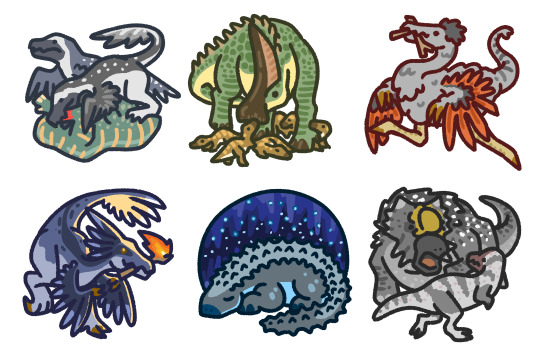
Prehistoric Planet Episode 4 - Ice Worlds
This was my favorite episode so far, what with the goofy bandit Ornithomimus, adorable baby Olorotitans, and the awesome Pachyrhinosaurus/Nanuqsaurus standoff. The real star of the show, however, was the Pyromaniac Troodontid.
#prehistoric planet#prehistoric#paleo#paleo art#dinosaur#dinosaurs#dinosaur art#dromaeosaur#olorotitan#ornithomimus#troodont#troodontid#burn it all down#antarctopelta#pachyrhinosaurus#nanuqsaurus#theropod#ceratopsian#arctic#digital art#funny little guys#my art
354 notes
·
View notes
Text
Submissions Open!
Edit: As of August 12th, submissions are now closed!
Please submit the name of your:
Fictional
Non-Avian (Triceratops - Troodont) Dinosaur, as well as:
Its franchise/series/work of origin!
Via the ask box!!
List of Current Potential Candidates. (Please check before submitting, and review the rules!)
Only 6 characters per franchise will be allowed in the final cut, but don't let that stop you for now! I will be doing the filtering later.
Feel free to submit a picture of the character if you're asking off anon (not required). Submissions will (probably) close on August 12th!
Thanks for reading, and please REBLOG to spread the word!
#saurnament#replacing my current pinned post with hopefully a more streamlined version#if you havent reblogged the original reblog this#or both i wont stop you#dinosaurs#dinosaur
6 notes
·
View notes
Note
An issue I see with spreading awareness of pterosaurs not being dinosaurs is that people overcorrect. Pterosaurs may not be dinosaurs (just like troodonts are not dromaeosaurs), but they are also stem-birds, and the major clade most closely related to dinosaurs. I've seen plenty of people insist they are "just reptiles far removed from dinosaurs", or "archosaurs, like crocs and dinosaurs". Archosaurs are crocs and birds, and pterosaurs are stem-birds, like every non-neornithean dinosaur. The least serious dinosaur mislabel IMO (unless we count Saltopus or other Triassic dinosauromorps), so focus should be made on them being close to (but not) dinosaurs. "Pterosaurs are relatives of dinosaurs" like, I dunno, "hippos are relatives of whales".
Yeah I'd agree with that. pterosaurs are close to being dinosaurs, but not quite. and that's a relevant thing
I think if we emphasize the dinosaur hip structure more, which seems to be the main characteristic of the group, that might help. Pterosaurs don't have open acetabulums (afaik. henry, if I'm wrong, I'm sorry). Dinosaurs do. Birds also do, and they're dinosaurs.
not that trait based classification is good or anything, but in this situation it works
33 notes
·
View notes
Text

really impressive puppet show, i enjoyed the episode i saw yesterday where Donkey Hodie said "we can do hard things" that was uplifting and not something ive really heard said before likeyes this thing is very hard but still, we can do it. i wanna know how they move the characters around bc the shots make it hard to tell.

really fucking ugly show to look at but irresistable if you have dinosaur autism, which they have an episode about. A dinosaur that is autistic, I mean. About dinosaurs. Reasearch is ususally accurate as far as it can possibly be (i.e feathered troodons, more heavily feathered alaskan troodonts)

i already talked about this

Extremely good show that just outright has divorced animal parents and people struggling. The animals movements are really inventive and inspiring if you are a guiy who draws funny animal people. The set & character design is off the charts good, another example probably of adults being furries and not being self-fulfilling only about that aspect of themselves. I watched this and got a good idea for communicating wit people i dont speak the same language as.

FINALLY!!!! I WAS LITTLE BROWN GIRL GROWING UP IN ALASKA!!!!!!! FINALLY! I ain't gonna go into how annoying it is being a brown non-native girl in alaska, but suffice to say this show probably would have gotten lots of other kids in the lower 48 off my back. Just really cool and features a segment with live action filmed IN alaska!! Makes my heart warm to see anyone care
Cyberchase and Wordgirl are on here too but i aint getting the pictures i already spent like an hour on this post
masterpost of pbs kids shows i like that are on the current air, in no order
imo these are the cream of the crop and very good for learning, even if you are not a child. There's lessons and shit for everyone



City Island is from a shootoff of the company that made Ugly Americans & Superjail, amons other familiar adult cartoons, btw
its about teaching civic values afaik

this show pisses me off alot but that's never a reason for it to be bad as a show. really i do enjoy the energy of it

probably the show on right now with the most pizzazz, lots of well-done effects and extremely enjoyable for children and adults alike which i think might be the purpose. Just really fun and silly, almost like men in black cartoon. I wonder if they get the most money for their show

fuck yes. animal powers. learning about animals. real world side by side with the Brothers Kratt, who are the main guys in the show. IDK. I may piss people off by saying this, but i dont have an ounce of respect for furries because i have yet to meet anyone coming at it from any angle which doesnt boil down to " This is about me and for me" whereas Wild Kratts is family working together on their love and admiration of the natural world together, playing and embracing being fun or silly, but like with a giving back teaching element. Basically the mosdt goated show on PBS kids rn I think. Everybody take lessons from them pls on how to keep you sexual appetite seperate from other things when it comes to being a furry adult. (lol furry adult) I have a feeling some of you will get the gist of what im saying here
16 notes
·
View notes
Text
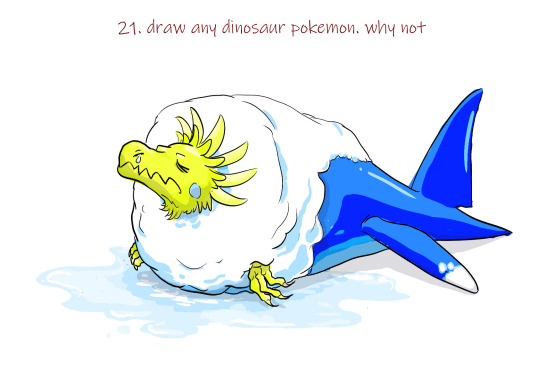
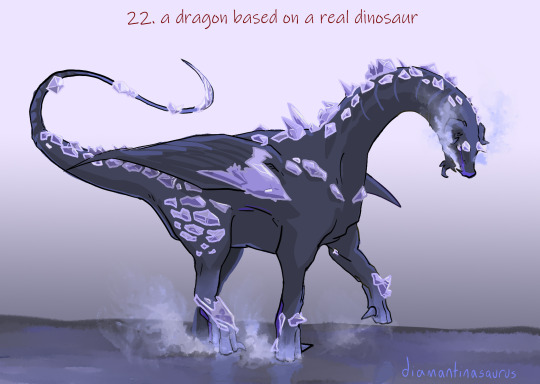
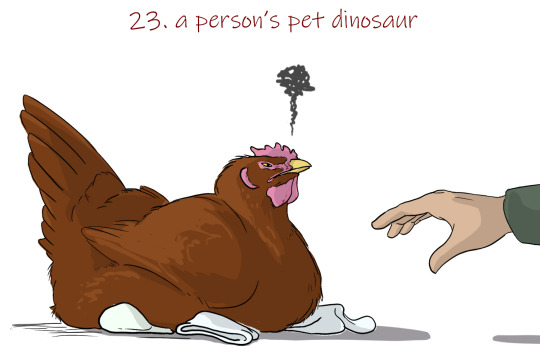



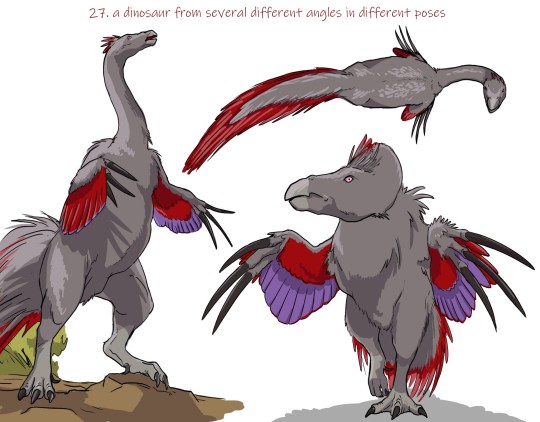
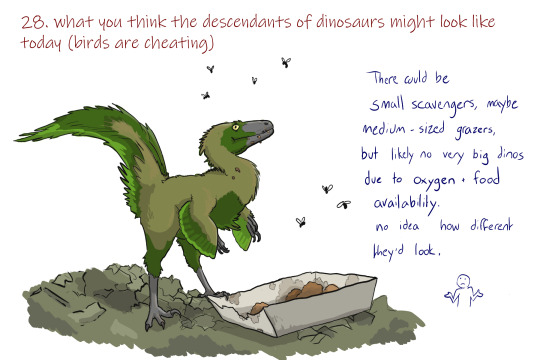

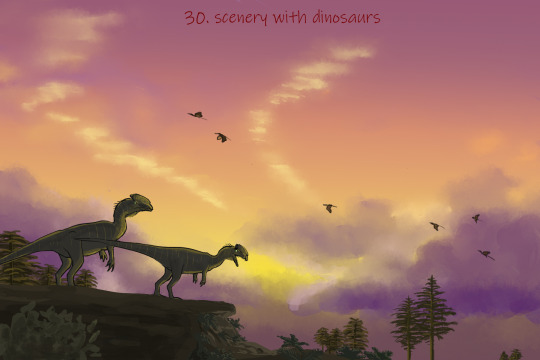
All done! Final part of the 30 day dino challenge
#dinosaurs#arctozolt#diamantinasaurus#baryonyx#30 day dino challenge#didelphodon#diplodocus#therizinosaurus#troodont#adelie penguin#dilophosaurus
71 notes
·
View notes
Text
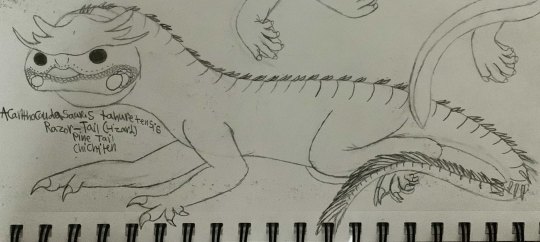
Razortail/Pinetail/Chichilen
Kingdom: Animalia
Phylum: Chordata
Class: Reptilia
Clade: Archosauromorpha
Clade: Crocopoda
Order: Rhynchosauria
Family: incertae sedis
Genus: Acanthocaudasaurus
Species: A. tahuretensis (“Tahureti spiny-tailed lizard”, “Tahureti” being a demonym for the historical region of Tahuret, a jungle and dry forest kingdom in northern Xenogaea)
Temporal range: Holocene to recent (10,000 kya - present); genetic divergence suggests a probable Miocene origin (10 mya - present).
Information:
A member of the rhynchosaur clade, this reptile’s placement within its own family is a contentious topic, in part due to its mix of basal and derived features. There are three competing theories regarding this, however: the first is that the razortail is a basal rhynchosaur which has convergently evolved derived rhynchosaur features (such as a partially beaked jaw), the second is that it is a derived rhynchosaur which has re-evolved several atavistic traits (such as the more slender, lizard-like build of earlier members of the clade), and the third and most widely-accepted theory being that it represents an early offshoot of the lineage leading to more derived forms, a so-called “missing link” between the two. Alas, this is not the only thing which makes this species quite unique compared to other members of its clade: an unusual example of an omnivore coming from an ancestrally herbivorous lineage, the razortail’s diet is best described as “indiscriminate”. Its main food sources consist largely of palm fronds, fallen fruits, nuts, seeds, large arthropods, small vertebrates (though it especially takes a liking for the multituberculates which share its habitat), and even eggs, the latter of which it actively seeks out. Individuals living in cities have been observed to even go after stray dogs and cats, as well as feral pigeons. Scavenging is also frequent, and cannibalism is documented but rare. Of course, with such indiscriminate dietary habits comes a high ecological pressure for competition, and as such, the razortail is fiercely territorial and reactive. However, while it extends such aggression towards its own kin mercilessly, rarely if ever tolerating the company of other razortails outside of its small hunting group, known as a caravan, with other animals, it is the embodiment of the phrase “its bark is worse than its bite”: it tends to flee from threats it does not believe it can successfully intimidate, though it may puff itself up and hiss and gurgle towards those it believes it can intimidate, throwing its spiny tail in front of it to add to the display. If approached or handled further, it may lunge forward, hissing and gurgling even more loudly, and will only bite if all else fails. The bite of this animal is deceptively strong, and can be strong enough to sever fingers and toes. That said, the amount of provocation it takes to get to this point is extreme, and to get bitten by this animal practically requires you to go looking to get bitten. Unfortunately, this animal often lives near human settlements, in part due to the easy source of food that is refuse piles and in part due to its acquired liking for coconuts and bananas, crops imported during medieval times by Austronesian sailors. As such, its relationship with the native inhabitants of the region is complicated, being simultaneously valued for its prowess for hunting the multituberculates and rodents which commonly eat crops but also detested or its own proclivity towards eating these crops itself.
Despite being only around the size of a Komodo dragon, this animal’s reputation far precedes it in the jungles and dry forests (and increasingly the neighboring grasslands) it calls home: this animal’s tendency to square up against significantly larger troodonts, dromaeosaurs, and even hyaenodonts has earned it the moniker of the “bulldog lizard” in some areas. Alas, this animal also squares up against rauisuchids and medium-sized theropods. So reviled is this creature by the animals it shares its ecosystem with, that dinosaurs which have lost chicks to razortails will abandon entire nests and start anew. Nonetheless, this animal is also preyed upon by the most brazen predators, its catalogue of predators including large theropods, amphicyonids, saber-toothed cats, prestosuchids, phytosaurs, hyaenids, hyaenodonts, oxyaenodonts, marsupial lions, sparassodonts, and humans. As such, this animal’s mottled, vibrant green and brown coloration is an adaptation which allows it to blend in with the foliage of its home. Another unique adaptation this animal has is its metabolism: a rare example of a heterothermic non-archosaurian diapsid, the razortail is able to inefficiently moderate its own internal temperature. However, as this is energetically costly, it typically relies on the surrounding environment to regulate its body temperature. With superb eyesight, the razortail is cathemeral and is able to be active in both the high afternoon sun and the pitch black of the midnight, hauling itself into the trees with its powerful forelimbs to sleep in the branches when not foraging or socializing. Able to run at speeds of up to 30 mph, this animal is also well-adapted for running fast in short bursts, something which aids it both in hunting and in fleeing from predators. This species appears to be uniquely resistant to the venom of many hymenopterans and snakes, the venom only knocking it unconscious for an hour or two before being metabolized. As such, it has little if any issue feeding on the nests of bees and wasps and is one of the few animals which control venomous snake populations. Some evidence suggest it engages in a form of commensalism with some species of therocephalians living in the same region as it, the more endothermic and muscular therocephalians serving as the brute force needed to make the kill while the razortails serve as the speed needed to corral prey into waiting jaws. This animal is quite versatile as well, and can regenerate damaged body parts with ease, even being able to regenerate parts of its eye if damaged. This species is one of the most successful in Xenogaea from a conservation standpoint, numbering nearly 2 million animals and counting, and its adaptability has allowed it to colonize previously uncharted territory for its species over a relatively short period of time, with most evidence pointing towards this species undergoing a distributive radiation. Likewise, this species’ presence in its native range is likely vital to the spread of the Xenogaean jungle pine, an araucarian conifer species found throughout the northern stretches of the Isle of Perils, as the razortail eats the cone by first crushing them before consuming them, spreading a few stray seeds on the ground in the process and allowing others to pass through its bowels to be excreted in its urea. Another thing to note about this bizarre creature is that the teeth at the front of the lower lip are fused into an exposed, bony plate whereas those on the top are concealed by lips.
In the winter months, when the tropical air is cooler, these animals are one of the few to make love. Congregating in massive groups, the males, whose hormones turn their throat pouches a vibrant blue and red during the mating season, are drawn in by the pungent pheromones the female produces, which are often described as having a strong mushroom-like smell. Though the female will mate with as many males as possible to ensure the fitness of her clutch, males will still fight one another for mating rights. Mating usually occurs on the ground, but maybe also occur in the trees, and the males will usually bite down gently on the back of the female’s neck to prevent her from struggling during copulation. After the female has mated with as many viable males as possible, she will chase away any other suitors aggressively. In a few weeks, she will lay a clutch of 20-30 leathery-shelled eggs in a small burrow at the foot of a tree, which she will guard ferociously, continuously adding and removing dirt as needed and only leaving the burrow for short periods to eat and drink, something which is risky, given that other razortails might eat her clutch. Sex determination is based on temperature, with the colder eggs producing males and the warmer eggs producing females. In roughly 5 weeks, the eggs will hatch and the young are cared for by the mother for roughly a year, after which they are big enough to fend for themselves. Full size is reached at 5 years old and sexually maturity at 7 years old, and in the wild, the young may live to nearly 20-25 years old, whereas in captivity, they may live as long as 30-40 years old. Homosexual behavior is extensively documented in this species, with both males and females engaging in same-sexual copulatory behaviors such as mounting. In fact, an estimated 50% of razortail sexual encounters are same-sex.
As touched on earlier, this species has a long and highly-complicated relationship with the native inhabitants of the region: simultaneously treated as a savior from pest animals which feed on cash crops and as a nuisance for feeding on said crops itself, captive-bred razortails appear to be undergoing a form of domestication, the first instance of true domestication ever being documented in a nonavian and non-archosaurian reptile. These captive-bred razortails are stockier, have larger eyes, and appear to be undergoing greater encephalization than their wild-born cousins. In captivity, they are used as pest control and guard dogs, their aggression deterring large predators and humans looking to do harm alike. However, its tendency to see other domesticated animals as potential prey make it extremely difficult to keep in close quarters with other pets, especially birds and rodents. Hence, most house-trained razortails are either kept alone, kept with a companion, or sleep outside. Captive-bred specimens are often given a very diverse diet, with the most highly-recommended diet consisting of mice, fish, crab (used as a substitute for the giant invertebrates it normally hunts), lettuce, celery, tomato, avocado, mango, peanuts, bananas, and strawberries. Likewise, this species is exceptionally emotionally intelligent, forming a similar level of emotional connection to its caretakers as dogs, chirping, grumbling, and rumbling to convey happiness to its owner. Its flesh is variously considered a delicacy in some areas, its taste supposedly being gamey and not unlike goat meat. That said, it is tough and sinewy, which makes it difficult to cook properly. Though fossils of this species are quite young, only going back to the very beginning of the Holocene around 10,000 years ago, genetic divergence when comparing its genetic sequence to close relatives indicates its lineage likely originated around 10 millions years ago in the Miocene.
#scifi#fantasy#speculative evolution#novella#rhynchosaur#creature design#creature art#speculative biology#speculative zoology#speculative fiction#worldbuilding#spec evo#sci-fi creature#fantasy creature
4 notes
·
View notes
Photo

20 años de vida en forma de gata y un cómic. Creo que nunca el humano llegará a amar la mitad siquiera de bien que ama una gata, un perro o algún otro animal. . . Pronto reseña de este cómic. Estoy con muchas lecturas al mismo tiempo, por eso la cantidad de libros distintos estos días. . . Cómic de @viktor_d_leon . . . . . . . . . . . . . . . . . . . #Librosygatos #gata #animaleslectores #libros #lectura #comic #cómic #librogram #librogrammerchileno #chilelibros #libros #libro #arte #literatura #artelatino #artelatinoamericano #mitaddelbigote #troodont #animales #chileno #instalike #chilegram #instachile #santiago #chilenos #celes #ermitañodelosgatos #lectores #librogramchile (en Peñalolén, Chile) https://www.instagram.com/p/B1omlllpSz8/?igshid=qvkoox7i7lzh
#librosygatos#gata#animaleslectores#libros#lectura#comic#cómic#librogram#librogrammerchileno#chilelibros#libro#arte#literatura#artelatino#artelatinoamericano#mitaddelbigote#troodont#animales#chileno#instalike#chilegram#instachile#santiago#chilenos#celes#ermitañodelosgatos#lectores#librogramchile
0 notes